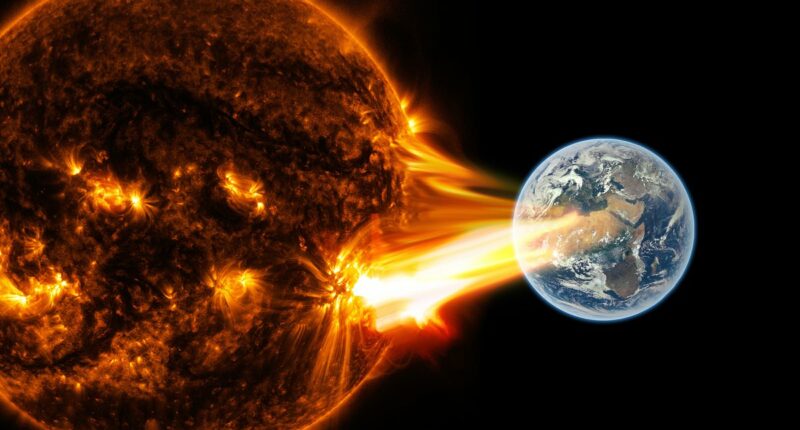Share this @internewscast.com
Earth is bracing for a significant influx of charged solar particles, set to commence on Wednesday.
At around 12 p.m. ET today, officials issued a warning about the impending solar event, which could potentially spark a severe geomagnetic storm, reaching a G4 level on NOAA’s scale.
The G4 classification is the second most intense, with the potential to cause extensive technological disruptions. The alert also suggested that the intensity could surpass current predictions.
The US Space Weather Prediction Center (SWPC) reported that some electrical grid systems might temporarily fail, spacecraft could encounter increased drag or surface charging, and high-frequency radio communications might experience interruptions or outages lasting several hours.
Additionally, mobile phone networks might face disruptions, as solar activity can interfere with satellite transmissions, affect GPS timing, or cause brief power losses at cell towers.
As a result, users might experience slower service, dropped calls, or temporary coverage losses in certain regions.
The strongest effects are expected at high latitudes, including much of Canada, Alaska, northern Europe, Scandinavia and parts of Russia.
However, auroras, satellite issues, and power disruptions could extend to mid-latitude regions such as the northern US and central Europe.

Officials issued an alert today around 12pm ET, warning that the incoming solar activity could trigger a severe geomagnetic storm, reaching the G4 level on NOAA’s scale (STOCK)
‘Detrimental impacts to some of our critical technology are possible, but mitigation is possible,’ SWPC said. ‘ The general public should visit our webpage to keep properly informed.’
The storm warnings, ranging from moderate to severe over the next few days, are caused by coronal mass ejections (CMEs), massive bursts of solar plasma and magnetic fields that erupted from the sun starting on November 9.
The SWPC’s list of watches includes a moderate G2 for today, followed by a G4 on Wednesday and a strong G3 is expected for Thursday.
The two powerful CMEs racing toward Earth are not ordinary solar eruptions, but are known as ‘Cannibal CMEs.’
These happen when a faster-moving ejection from the sun overtakes an earlier one, merging into a massive shock wave that can supercharge geomagnetic storms once it collides with Earth’s magnetic field.
Tony Phillips of spaceweather.com said: ‘Strong geomagnetic storms are possible on Nov. 12th when two CMEs are expected to hit Earth’s magnetic field. In fact, the two storm clouds could merge to form a potent ‘Cannibal CME.’
‘Cannibal CMEs contain shock waves and enhanced magnetic fields that do a good job sparking and amplifying geomagnetic storms.
‘The last time one hit, on April 15, 2025, it caused a severe G4-class storm with auroras sighted as far south as France.’

The solar flare that erupted early Tuesday was identified as the largest in 2025 (PICTURED)
The solar flare that erupted early Tuesday was identified as the largest in 2025.
The flare caused a radio blackout across Europe and Africa around 5am ET, briefly affecting aviation, maritime, emergency, GPS, radar and satellite communications.
Space scientist Steph Yardley described the solar activity as ‘not very common,’ noting these extremely energetic particles from the sun are so strong that ground-based detectors can pick them up.
‘There have been 75 recorded since 1942,’ she posted on X.
This flare came from sunspot AR4274, which has been highly active in recent days, producing two other significant flares on November 9 and 10.
Sunspots are temporary, darker patches on the sun’s surface that are cooler than the surrounding areas.
Officials warned that high-energy particles from the sun are triggering radiation alerts.
Passengers and crew on high-altitude polar flights may face slightly increased exposure. Satellites in low-Earth orbit, especially those flying over the poles, are vulnerable to temporary electrical disruptions.

A stunning image of the sun as it released the powerful solar flare
Solar activity is expected to stay high because sunspot AR4274 is still facing Earth and is unstable. There’s a 75 percent chance of more medium (M-class) flares, which could cause brief radio blackouts, disrupt high-frequency communications and trigger minor geomagnetic storms, EarthSky reported.
There is also a 40 percent chance of another strong X-class flare, which could lead to widespread radio blackouts, interfere with satellites and GPS systems, affect power grids, and pose radiation risks to astronauts and high-altitude flights.
Another sunspot, AR4276, could also produce smaller flares with minor effects as it develops.









